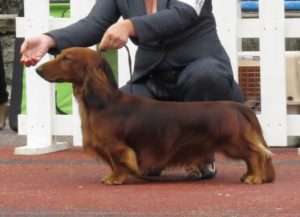Dachshunds 101
Dachshunds 101
 The word Dachshund is German for “badger dog,” and the name couldn’t be more appropriate for this iconically shaped dog breed.
The word Dachshund is German for “badger dog,” and the name couldn’t be more appropriate for this iconically shaped dog breed.
With an elongated physique, and a shorter stature than most dogs of the same size, Dachshunds have been bred to be natural born hunters since the 1500’s. Their long noses are ideal for burrowing to find prey in tight spaces, and they have wide chests to maximize air flow to their lungs should a chase in the woods ensue.
Many Doxies (short for Dachshunds) have moved on from the hunting grounds to become favorites among urban and apartment dwelling dog lovers— in fact, the American Kennel Club (AKC) ranked Dachshunds as the 13th most popular dog breed in 2015.
Many Doxies (short for Dachshunds) have moved on from the hunting grounds to become favorites among urban and apartment dwelling dog lovers— in fact, the American Kennel Club (AKC) ranked Dachshunds as the 13th most popular dog breed in 2015.
Why do some Dachshunds look different?
Many people are surprised to learn that Dachshunds have three different types of coats: smooth or short-haired, long-haired, and wire-haired. Their coats come in 12 colors and have three distinct types of markings.
Doxies with short coats have shiny, smooth fur that lays flat against the body. Their coats are very low maintenance and require infrequent brushings just to stimulate the skin and healthy circulation.

A beautiful long-haired dachshund in Eastern Europe
Long-haired Doxies have silky, wavy coats that, according to Pedigree, “…are the product of smooth-haired Dachshunds crossed with Spaniels and Irish Setters.” Longer coats must be brushed regularly to avoid knotting.
Wirehaired Doxies are the least popular type of coat in the U.S., but the most popular coat in Germany. They have short, fuzzy hair that needs regular brushing and a routine “stripping of the coat” at least two or three times per year. This prevents the coat from becoming too thick, which could lead to excessive knotting or matting.
Dachshunds tend to shed, however, they do not shed excessively. If allergies are a concern, the wirehaired Doxies are your safest bet. These Dachshunds are much more hypoallergenic than the short or long-haired ones.

Color lithograph from 1875 of a Dachshund confronting a badger
(Dachshund is German for “badger-dog”)
Why do Dachshunds have long ears?
Dachshunds actually belong to the hound group of dogs, making them similar to Bloodhounds and Basset hounds. Two key characteristics of this group are long, floppy ears and a knack for hunting.
Dachshunds, like most hounds, rely primarily on their noses to guide them, sometimes while running at full speed. With their noses to the ground, their long ears stir up and trap scent molecules that they pick up along the chase to enhance their sense of smell even further.
Are Dachshunds prone to ear infections?
Due to the long nature of their ears, Doxies are more susceptible to ear infections since their ears don’t receive the proper air flow. This means routine and regular ear cleanings are a must. A gentle ear cleaner like EcoEars is the perfect solution for preventing infections and ear mites in Dachshunds.
You’ll also need to pay attention during bath time. It’s important that you make sure water stays as far away from your Doxie’s ears as possible. Any excess moisture is likely to get trapped inside the ear canal, which will cause problems.
If you notice these symptoms in your Doxie, take a trip to your vet as soon as possible:
- Ear scratching
- Ear rubbing on the floor
- Excessive head shaking
- Odors or discharge from the ears
Keep an eye on your Dachshund’s ears to see if bald patches start to develop. A condition known as pinnal alopecia, which is more common in males, presents itself in the form of progressive hair loss behind the ears and advances to the point of complete baldness when they’re older.
If you notice any changes in your Doxie’s ears, visit your vet immediately to rule out other possible conditions such as ringworm or a yeast infection.

Dachshund Puppies
(oil on acrylic)
What kind of temperaments do Dachshunds have?
An interesting fact is that each Dachshund’s coat seems to carry its own personality with it.
Pedigree mentions that short-haired Doxies tend to be “more attached” to their family members and are also on the energetic and loving side.
Long-haired Doxies have much calmer and gentler temperaments thanks to their terrier mix. Of all three coats, these Doxies prefer less exercise and enjoy taking things easy.
The wirehaired Dachshunds take the cake for having the most personality and energy of all three coats. These Doxies love to play for hours and enjoy being the center of attention.
What other personality traits do Dachshunds have?
You may find that your Doxie loves to burrow underneath covers just as her ancestors used to burrow in the ground for prey, so don’t be surprised if you find your Dachshund deep in the bed sheets or your flowerbed.
Dachshunds enjoy acting like guard dogs so you’ll typically find them keeping a vigilant watch while they remain “on the lookout” at home. If they sense something’s up, they’ll immediately react by barking in a deep tone that lets people know they may be small, but they mean business.
Due to their hunting background, this type of barking is all too common. You should understand that it may seem like your Doxie is barking too much, but in reality, she’s simply following her instincts and doing her job by protecting her space.
This protective nature is also what makes Doxies difficult around small children. Their possessive and defensive nature can make them feel threatened when someone such as a small child invades their space. Instead of seeing this as playtime, they may respond by biting.
Doxies do best in households with older children who can understand a Dachshund’s need for their space and toys to be left alone, or until they’re ready to play.

Choco PUP by tangerinesun, photographed learning “sit” command.
What kind of exercise requirements do Dachshunds have?
Despite their short legs and small stature, Dachshunds enjoy eating all the time. But any extra weight can put an unnecessary and unhealthy strain on their sensitive backs and small legs.
Doxie parents must take their pups for walks to prevent obesity from happening. Even long-haired Dachshunds who prefer less activity should still receive some form of exercise each day. Doxies especially love to run around and chase small animals so be sure to enclose any area that you plan on letting your Doxie loose in.
Plan for a little extra activity if you have a high-energy short-haired or wire-haired Dachshund. If they guys don’t get to work out their extra energy, they’re likely to take it out by doing something they’re not supposed to (i.e. excess chewing, constant searching for food, etc.).
How do Dachshunds take to training?
Dachshunds are feisty and sometimes stubborn dogs. Therefore, training them takes patience and resilience. You’ll want to have treats handy since they’ll pretty much do anything if they know their reward is food-related.
Keep in mind that Dachshunds prefer to be in charge, so telling them what to do may not always be easy. If done incorrectly, they’ll show their teeth in resistance and may even resort to nipping to prove their point.
That’s why a calm and patient manor is needed to train these headstrong pups. This same concept holds true for housetraining. It may take your Doxie a little longer than some other breeds, so if you’re having trouble in this department, you may want to seek out a professional dog trainer’s help.
Whatever you do, do not scold your Dachshund if she’s not catching on. These dogs are used to being independent hunters so it will take some time for them to adjust to listening to commands, but that doesn’t mean training them is impossible. In order to be great hunters, they had to learn specific commands, which means your Doxie is more than capable of catching on to a few tricks.
Are there any other health concerns to worry about with Doxies?
Unfortunately, due to their shape and genetic predisposition, it’s common for Dachshunds to have certain health issues.
The most common health concern among Dachshunds is slipped spinal discs. If this condition occurs at an extreme level, paralysis is inevitable. On a small scale, you may notice that your Dachshund is not walking properly or has trouble placing weight on her hind legs. That’s why it’s crucial that your Doxie steers clear of jumping on and off the couch or anything high up, and avoids running up and down stairs altogether.
It’s also a good idea to make sure they keep all four paws firmly planted on the ground. Dachshunds are notorious for sitting up on their hind legs in an upright position. This posture can put an unnecessary strain on their lower backs and spines. Although it may be cute to see them sitting upright like a little human, it’s very bad for their backs and should be avoided at all times.
Some Doxies are also more prone to conditions such as obesity, heart disease, and/or diabetes due to their aggressive appetites. To prevent these life-threatening conditions from happening, you’ll need to monitor their food and treat intake to ensure that they’re not overeating and you’ll need to take them out for exercise each and every day.
In less rare cases, Doxies can also be susceptible to issues like urinary tract problems.
Some Dachshunds may even be predisposed to serious conditions such as cancer, hypothyroidism, and fatty tumors. To keep your Doxie safe, run your hands along their coat each day and visit your vet regularly to ensure that any possible tumors are detected early enough. The earlier you can detect a tumor, the higher the chance of survival.
Now, hypothyroidism, on the other hand, cannot be detected by a physical exam so routine vet visits are the only way to know for certain if your Dachshund is at risk for it.
Dachshund Rescue Groups
Because Doxies aren’t so great with children and their strong personalities can be tough for some people to handle, many loving Dachshunds find themselves in local shelters through no fault of their own.

Visit Dachshund Rescue of North America
(DRNA)
on Facebook
Luckily, non-profit, breed-specific rescue organizations such as Dachshund Rescue of North America, Furever Dachshund Rescue, and Almost Home Dachshund Rescue, exist to keep these beautiful dogs out of shelters.
These amazing organizations work tirelessly to foster these dogs in an effort to understand their personality and temperaments before placing the Doxies in forever homes. This guarantees that the new pet parents are fully aware of what to expect with their long-bodied addition. The DRNA even improves the potty training of not-already-house-trained dogs before they are placed for adoption.
These extra measures help to keep Doxies out of shelters and foster care and into homes that will accept them as lifetime family members.
We recently learned that one of our readers, Naomi from Arizona, has fostered 52 Dachshunds! Sounds like this breed inspires loyalty and dedication indeed.
Celebrities and their Dachshunds

Famous Doxie Owners
Dachshunds are a breed adored by many. But it’s not only regular folks who love Dachshunds. Many notable legends and celebrities have enjoyed the company of a Dachshund or two and have been spotted with this tough, yet small breed strolling by their side.
I Love Dachshunds notes that celebrities such as Sharon Stone, Kim Cattrall, and Kelsey Grammer all have a special soft spot for Doxies.
John F Kennedy, Jacques Cousteau, Queen Elizabeth, Marilyn Monroe, Pablo Picasso, Marlon Brando, Paul Newman, and Joanne Woodward have all been pictured holding their beloved Dachshunds as well.
If you ever have the pleasure of meeting a Doxie, be sure to approach them in a gentle and calm manner. For safety reasons, you may want to keep small children away from them, unless they are able to understand that Dachshunds need extra space.
Toughness aside, Doxies are one of the most loyal and enjoyable dog breeds you can find. As long as they get enough exercise each day and they’re limited on how many extra treats they receive, they can live a long and healthy life lasting anywhere from 12 to 15 years.
